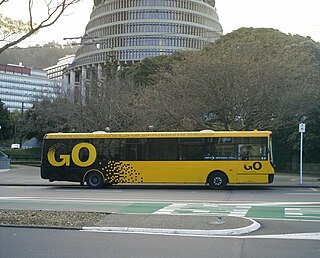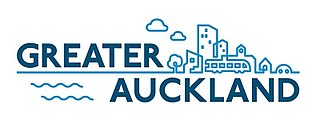Jafa is a slang term for a resident of Auckland, New Zealand. It is an acronym, standing for Just Another Fucking Aucklander. This prejudice against Aucklanders started to appear around the 1900s, when Premier Richard John Seddon referred to Aucklanders as "Rangitoto Yanks," and is considered to be representative of the boorishness of Aucklanders, or the envy of the rest of New Zealand, depending on the perspective. The term is also misspelled as Jaffa, a chocolate confection from Dunedin, and is often used in sentences which render the original term useless in the grammatical sense. The term has wider currency than the earlier derogatory term "Rangitoto Yank". A variant is Jaffa, Just Another Fuckwit From Auckland.
Tranz Rail, formally Tranz Rail Holdings Limited, was the main rail operator in New Zealand from 1991 until it was purchased by Toll Holdings in 2003.
Tranz Metro was a New Zealand public transport operator. Beginning as the New Zealand Railways Corporation's Cityline division as a result of restructuring in the 1980s, in its final form Tranz Metro was the operator of Metlink's suburban trains owned by the Greater Wellington Regional Council in the Wellington Region of New Zealand.

NZ Bus is New Zealand's largest bus company, operating in Auckland, Tauranga and Wellington. Formerly a subsidiary of Stagecoach Group and later Infratil and Next Capital, it is now owned by Kinetic Group.
Transdev Auckland, formerly Veolia Transport Auckland, and Connex Auckland was a subsidiary of Transdev Australasia that ran Auckland's urban passenger trains under contract from Auckland Transport on infrastructure owned and managed by KiwiRail. Auckland Transport receives funding to subsidise these services from the NZ Transport Agency, which receives funding from road user taxes and Crown appropriations, and from the Auckland Council through rates.

The Central Connector, is a bus route between Britomart Transport Centre in the Auckland CBD, New Zealand, and the commercial suburb of Newmarket. It has some aspects of a bus rapid transit link. It was expected to improve journey times by about 14 minutes for around 2,600 buses per week, about 65,000 passengers daily. Work began in April 2008 and is now finished.

GO Wellington was the brand name of Wellington City Transport Ltd, the Wellington subsidiary of NZ Bus, in New Zealand. The company was branded Stagecoach Wellington by its previous owner, the Stagecoach Group. The current name and a new livery were announced in November 2006 by NZ Bus owner Infratil.

Ritchies Transport is a New Zealand private bus operator, owned by KKR. It was established in 1972 and describes itself as "the largest privately owned bus and coach transport operator in New Zealand" with a fleet of over 1500 vehicles spread across depots nationwide. It owns a 46% stake in InterCity.

Public transport in New Zealand exists in many of the country's urban areas and takes a number of forms. Bus transport is the main form of public transport. Two major cities, Auckland and Wellington also have suburban rail systems that have been gaining more patronage and new investment in recent years. Some cities also operate local ferry services. There are no rapid transit metros and no remaining tram systems active anywhere in New Zealand, though trams once had a major role in New Zealand's public transport.

Public transport in Auckland, the largest metropolitan area of New Zealand, consists of three modes: bus, train and ferry. Services are coordinated by Auckland Transport under the AT Metro brand. Waitematā railway station is the main transport hub.

Auckland railway electrification occurred in phases as part of investment in a new infrastructure for Auckland's urban railway network. Electrification of the network had been proposed for several decades. Installation started in the late 2000s after funds were approved from a combination of regional and central government budgets.

The AT HOP card is an electronic fare payment card that was released in two versions on Auckland public transport services, beginning in May 2011. The smart card roll out was the first phase in the introduction of an integrated ticketing and fares system that was rolled out across the region.
AT Metro is the public transport brand in Auckland, New Zealand, managed by Auckland Transport. It was launched in December 2014, following the decommissioning of the MAXX brand with updated bus and train liveries, staff uniforms, wayfinding signage and a refreshed external communications identity.

Great Journeys New Zealand is the tourism division of KiwiRail that operate its three Scenic train services. The new division was launched in May 2017 and replaced the former tourism brand KiwiRail Scenic Journeys. It has continuity with the earlier InterCity Rail (1987–1995) and Tranz Scenic (1995–2011).

The Tranzit Group is a company that operates buses in New Zealand. It was founded by Albert Snelgrove as Grey Bus Service in 1924. It became Blue Bus Service in the early 1950s and then Tranzit Coachlines in 1985. It has a 46% shareholding in InterCity.
The North Shore Line is a proposed commuter rail or light rail line that would serve the North Shore of Auckland, New Zealand.

Greater Auckland is a non-profit group that advocates for public transport and urbanism in Auckland, New Zealand. The group was originally founded as the Auckland Transport Blog but has since evolved to analysing and publishing on a number of Auckland issues.
National Ticketing Solution (NTS) is a public transport payment system in development for New Zealand. It is contracted to American company Cubic. It is expected to start roll out in the Canterbury region in 2024 and available nationwide by 2026.













